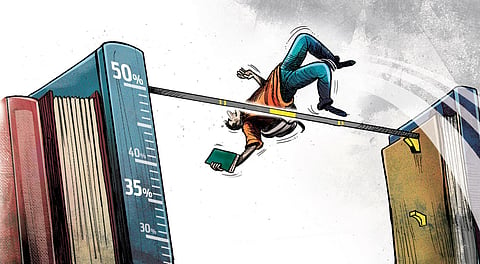

THIRUVANANTHAPURAM: Academic circles have been debating the drop in the quality of higher education in the state over the years, but have not examined the issue in detail due to the lack of a concrete mechanism to gauge the decline.
The introduction of the National Institutional Ranking Framework (NIRF), by the Union government in 2016, not only brought in a common yardstick for grading higher educational institutions across the country but also put the spotlight on the accountability of such institutions.
A closer look at the rankings of universities over the past five years shows that of the 16 state universities, only four have been able to figure in the top 100 rankings. Barring Calicut University that has shown an inconsistent trend, University of Kerala and MG University have been able to maintain consistency in their rankings. Notably, Cochin University of Science and Technology (Cusat) has shown improvement with every passing year, bettering its ranking of 86 in 2017 to 44 in 2021.
Interestingly, 19 universities from Tamil Nadu and 10 from Karnataka were able to find a place in the top 100 all-India rankings this year compared to just four from Kerala. Though 19 colleges in the state found a place in the top 100 national rankings, the state had no representation in the top 100 positions among dental, pharmacy or research institutions this year which, educationists say, is a worrisome trend. Experts have also been lamenting the poor quality of research in institutions of higher learning.
“We can’t say that the NIRF ranking is a foolproof indicator of the standards of higher education sector as a whole. However, it gives us a basis to move forward. Besides, it has also helped bring in some academic accountability. We need to seriously focus on the parameters where our institutions are lagging behind,” said noted educationist R V G Menon. Menon pointed out that historically, research has not been part of undergraduate education in the state.
Neither has a proper research environment been created in institutions. In teacher selection and teacher evaluation too, research has not been made a key criterion, he said. The educationist reminded that in higher educational institutions abroad, a major yardstick of accountability is research publications. According to educationists, the state had neglected ranking and accreditation mechanism over the years. The state, on the other hand, was keen on ensuring that all sections of society were able to access higher education rather than striving to create institutions of excellence.
However, ranking and accreditation were taken seriously only when funding for institutions began to be linked to these factors. “Since our higher education sector focused more on social aspects and distributive justice over the years, only moderate achievements could be made in teaching, learning and research. Unfortunately, the national rankings do not take into account social justice imparted in the sector or social mobility ensured,” said Rajan Varughese, member secretary, Kerala State Higher Education Council (KSHEC).
Varughese said Kerala has a better Gross Enrolment Ratio (GER) than states which boast of institutions of excellence. The higher number of girls and SC/ST category students accessing higher education in the state is an achievement. However, it is not included as a parameter in the rankings, he pointed out.
NAAC grades
Meanwhile, when it comes to grading of institutions by the National Assessment and Accreditation Council (NAAC ), only six of the 16 state universities figure in the council’s grading system, according to the All Kerala Higher Education Survey (AKHES), 2020.
While four universities have been awarded ‘A’ grade, one university has managed ‘B’ grade while another has secured ‘B++’ grade. While 211 colleges have secured grades ranging from A to C, six “transition autonomous colleges” managed to secure A grade. Interestingly, the two colleges in the state that have been able to secure the highest NAAC grading of A++ are autonomous colleges, according to AKHES, 2020 prepared by KSHEC.
“The rate of attainment of NAAC ‘A’ grade by colleges in the state is definitely higher when compared to other states,” said R Jayaprakash, former executive council member of KSHEC who was part of the NAAC peer team that visited dozens of higher educational institutions for accreditation.
“Even though the state’s institutions fare well in infrastructure- related aspects, teaching, learning and evaluation that carry higher weightage need to be improved,” he added. The NAAC grades range from A++ (highest) to D (not accredited). While the A++ graded institution has to secure a Cumulative Grade Point Average (CGPA) ranging from 3.51 to 4, an institution scoring CGPA of 1.5 or less is not accredited.
FALLING STANDARDS
Issues in the higher education sector in the state have been a hot topic for debate in academic circles for quite some time. With Governor Arif Mohammed Khan, who is also the chancellor of universities in the state, flagging the unhealthy practices and unnecessary interventions by the government, the issues have triggered a public debate again. In a three-part series, TNIE examines how deep the rot in Kerala’s higher education sector is
A worrisome trend
Though 19 colleges in the state found a place in the top 100 national rankings, the state had no representation in the top 100 positions among dental, pharmacy or research institutions this year which, educationists say, is a worrisome trend.